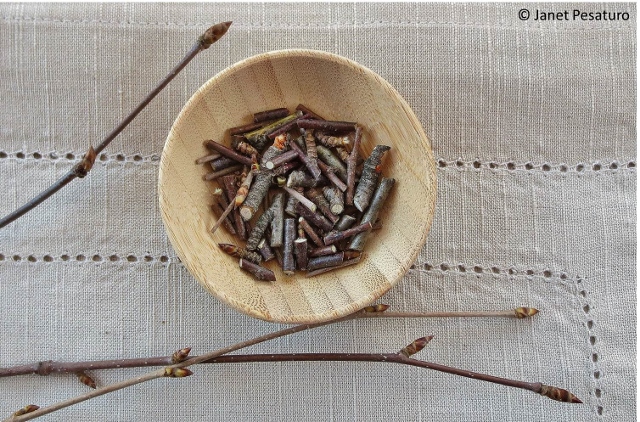
Yellow birch twigs have been chopped into small pieces and will be used to make wintergreen extract.
I recently wrote about making an extract of wintergreen (methyl salicylate) from the tiny ground cover, Gaultheria procumbens, which goes by the common name wintergreen . You can see that post here. But that little ground cover is not the only plant that produces wintergreen. Both sweet birch and yellow birch, two trees of our temperate forests, also produce methyl salicylate, and can be used to make the same extract. Which plant is the best one to use? That depends on where you live: Use the one that’s most common in your area. If they’re all common on your stomping ground, go with one of the trees, since removal of a few twigs has a negligible impact on a tree.
Both sweet birch (Betula lenta) and yellow birch (Betula alleghaniensis) are fairly easy to identify. They can be used to make wintergreen extract at any time of year, but the lean winter season is a good time, because there aren’t a lot of other wild edible options. So I will focus on winter identification of these trees.
Sweet birch, Betula lenta
This is a common tree of deciduous temperate forests of most of the eastern US and Ontario, as shown in this range map. It prefers good sun exposure and acidic soil. It’s fairly easy to identify by its bark, but the bark appearance does change as the tree ages. On a young tree, the bark is smooth and dark with small, horizontal lines called lenticels. As the tree grows, the bark begins to develop vertical cracks, and eventually scaly plates, as you can see in the photo. However, it’s important to note that using bark characteristics alone can lead to confusion of sweet birch with black cherry (Prunus serotina), which has bark that looks like this.
The scratch and sniff test will help you distinguish black birch from black cherry. Scratch open the bark on a small twig, and sweet birch will smell pleasantly minty. Do the same to black cherry, and you will notice an unpleasant odor that is not at all minty.
Sweet birch and black cherry both have alternate branching patterns, and their winter buds look somewhat similar, too. Sweet birch has long, pointy buds, as you can see in the photo below. Black cherry has somewhat smaller buds as you can see here. The difference is not tremendous, so you can see how important the scratch and sniff test is. At first, sweet birch and black cherry will appear very similar to you, but over time, you will learn to pick out the subtle differences between the bark and buds of these trees. Be sure to check at least one other source of tree identification.
Sweet birch should not be confused with river birch, Betula nigra, a tree of wetlands and flood plains. Unfortunately, both Betula lenta and Betula nigra are sometimes called black birch. It’s possible that river birch can be used to make wintergreen extract, but I have no experience with that tree, so I’m not recommending it.
Yellow birch, Betula alleghaniensis
Yellow birch ranges over most of the eastern US and Canada, as seen in this map. Its unique yellowish, peeling bark is easy to identify, except when the tree is very young. Yellow birch saplings have smooth, dark bark, but as the tree grows, fine, horizontal strips of golden bark peel off and curl, as shown in the photo below.
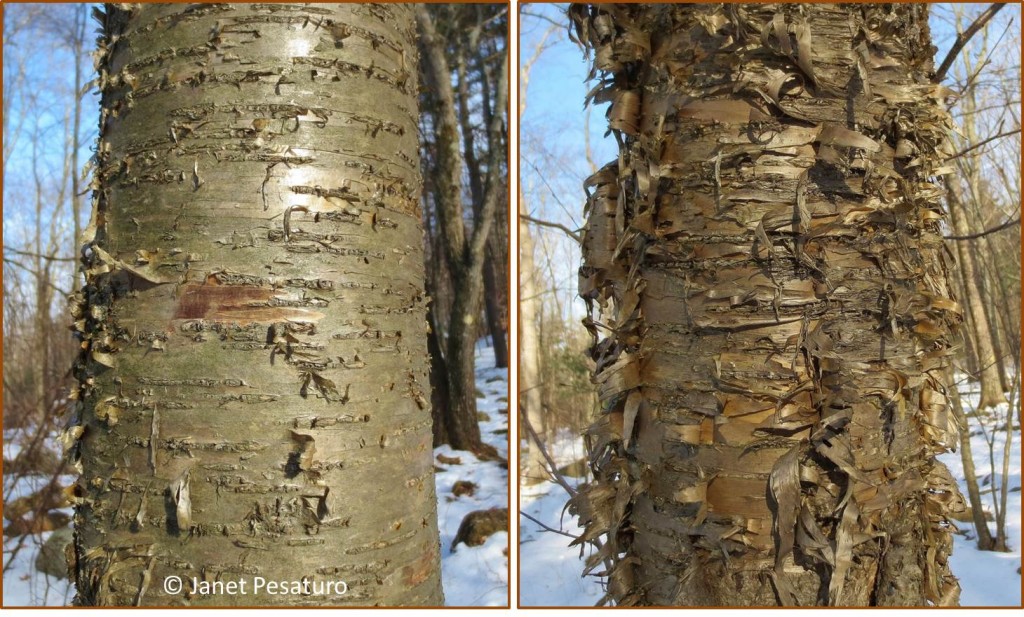
Yellow birch bark. The bark of the older tree on the right has many more peeling curls than the younger tree on the left. The bark of very young trees is completely smooth.
The twigs and buds of yellow birch look very similar to those of sweet birch. Scrape a twig and notice the minty wintergreen scent. It is slightly fainter than the wintergreen scent of sweet birch. I have read that “yellow birch tastes bitter”, but I do not notice a bitter flavor to the alcohol extract, so perhaps alcohol does not extract the bitter substance.
If you have both species in your area, sweet birch may be the better choice because it has the stronger wintergreen scent. However, if you are new to tree identification, it may be easier for you to definitively identify yellow birch, with its more distinctive bark.
Be sure to confirm identification with at least one other source before consuming any wild plant. This article is meant to inspire you and get you started. It is not meant to be THE authoritative source on birch identification. Never eat a wild plant until you are certain of its identity and edibility.
Edibility of wintergreen extract
Methyl salicylate (pure oil of wintergreen) is a lot like acetyl salicylate, which is aspirin. Like aspirin, it has medicinal qualities, such as anti-inflammatory and anti-fever properties. And, like aspirin, pure oil of wintergreen is toxic in large enough quantities. How large is large enough? A teaspoon (7 grams) of pure oil of wintergreen can kill an adult, and 4.7 grams can kill a child, as you can see here. But relax. An alcohol extract is not pure oil of wintergreen, and you wouldn’t consume a whole teaspoon at once. You would add about a teaspoon of an extract to an entire batch of cookies.
Make wintergreen extract from sweet or yellow birch
- With a sharp knife (which will need to be resharpened after this), chop the twigs into small lengths. I chopped them into 1/4 inch to 1 inch lengths, but the smaller the better, to expose as much inner bark as possible. Or, instead of chopping, you could scrape up the outer bark to expose the green inner bark.
- Fill a clean jar about 2/3 of the way with the chopped or scraped twigs.
- Pour in enough 80 or 100 proof vodka to cover the twigs.
- Let sit in a dark place at room temperature for at least several months, shaking every day or two.
- Taste it occasionally, and strain out the twigs when the wintergreen flavor is strong, or just leave the twigs in the extract.
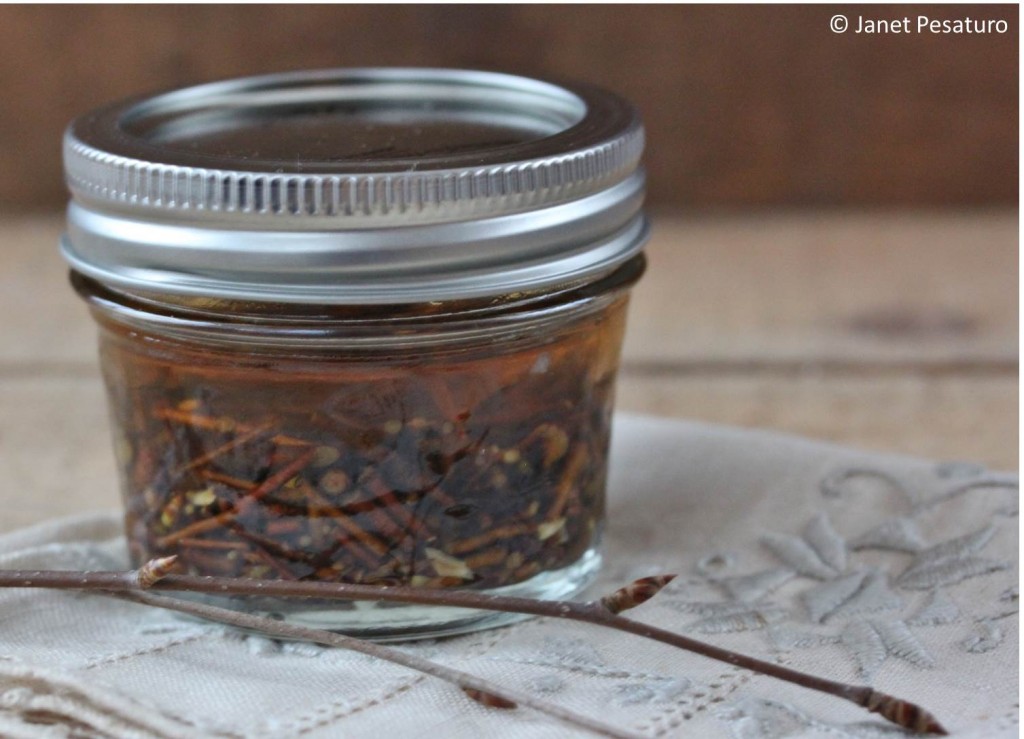
You can make wintergreen extract from birches, particularly sweet birch and yellow birch. Here I have used yellow birch.
What to do with your wintergreen extract? Try my wintergreen ice cream brownie torte.
Shared on: Weekend Wholefood Blender Part, Simply Natural Saturdays, Natural Living Mondays, Mostly Homemade Mondays, Thank Goodness it’s Monday, Backyard Farming Connection #63, Teach Me Tuesday, Tuesdays with a Twist #41, Fresh Foods Wednesdays #65, 120th Wildcrafting Wednesday, HomeAcre Hop #53, From the Farm Blog Hop, Simple Saturdays #7, Old Fashioned Friday #52, Waste Not, Want Not Wednesday #59, Wicked Awesome Wednesday #145, Time Travel Thursday #184, The 104 Homestead Blog Hop, Simple Life Sunday #3












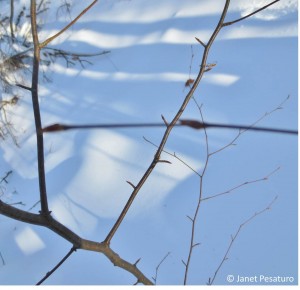
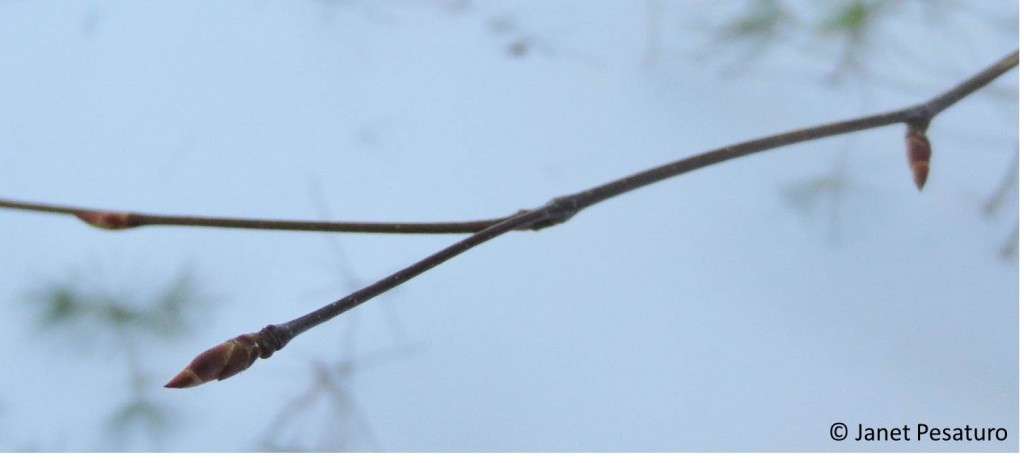
Love this article. The only birch we have on our property is a river birch. I’ll have to check it out to see if it’s minty. I’ll let you know what I find. Thank you for a fabulous read, so interesting.
Thanks, Toni! I would really love to know if river birch has that minty smell, so would love it if you did get back to me on that!
This is such a wonderful article! I just recently started making extracts of my own (vanilla, lemon, etc.) and now I think I will try wintergreen! I saw the recipe for wintergreen ice cream brownie torte in your previous post; do you have more recipes for using the wintergreen? Perhaps those cookies that you mentioned? Thanks!
Thanks, Vickie. I hope to post more wintergreen containing recipes eventually!
What a wonderful post! We have birch trees on our property, I may have to try this! Thank you so much for sharing your post on the HomeAcre Hop, hope to see you again tomorrow! – Nancy The Home Acre Hop
Thanks for stopping by, Nancy!
Pingback: Wintergreen ice cream brownie torte - One Acre Farm
How have I never heard of this? So cool. And I’m definitely interested in checking out your icecream brownie torte next! 😀
If you try the torte, please let me know how it comes out. I’m very interested in making my recipes glitch free. Thanks for stopping by!
Pingback: 15 Trees for a Wildlife-Friendly, Edible Landsape - One Acre Farm
I love this article, Janet. I had no idea that birch was a source of flavouring. They do make syrup from the sap around here. We have black birch (river birch) and paper birch here in the West. I’ll try the twigs and see if it works.
Thanks, Chris! After playing around more with it, I’ve decided it works best if you chop up twigs as finely as possible, use 100 proof vodka, and let it set for at least 6 months. Generally, using the little plant called wintergreen (Gaultheria procumbens) gives a stronger flavor, but this did worked. In baked goods it gives a subtle wintergreen flavor.
Pingback: Brush up on your Tree ID this Fall! | hortshorts
Pingback: Fresh, Green, and Wintry | Flowers, Plants n Blooms
Janet, thank you so much for this article! I have trees on my property that are either cherry or birch and I’ve been pouring through my tree ID books to figure out which they are. This article is the help I needed!
how much would I need (teasppon, ml?) to get the same effect as aspirin?